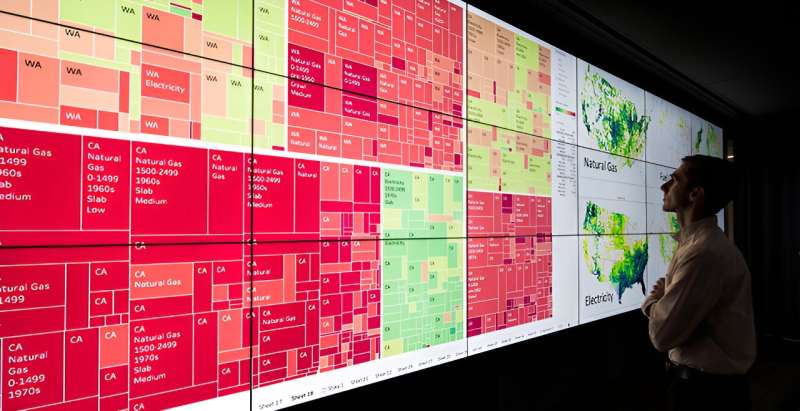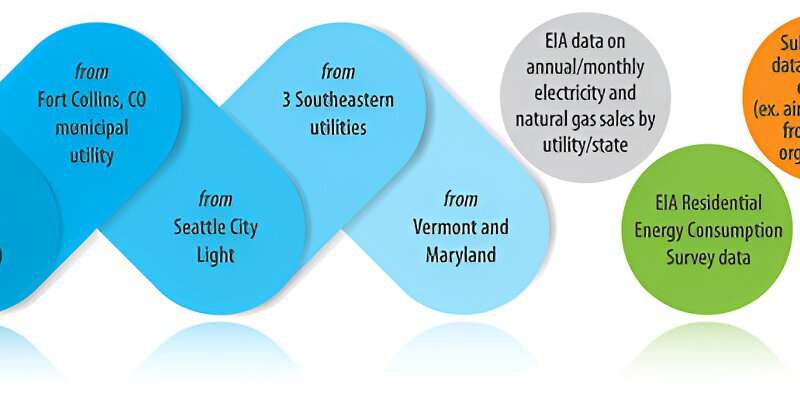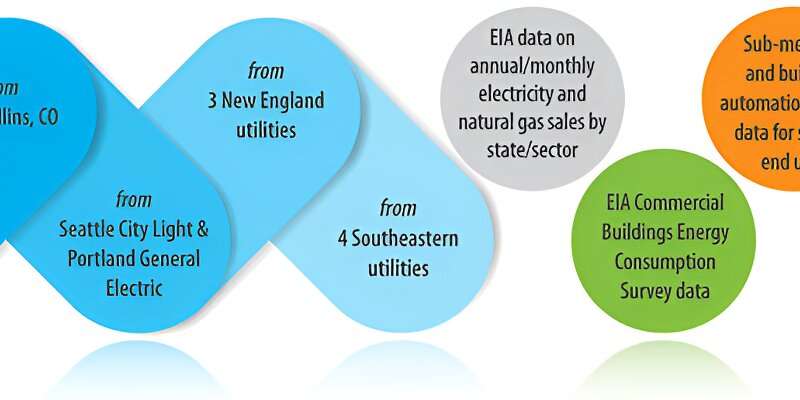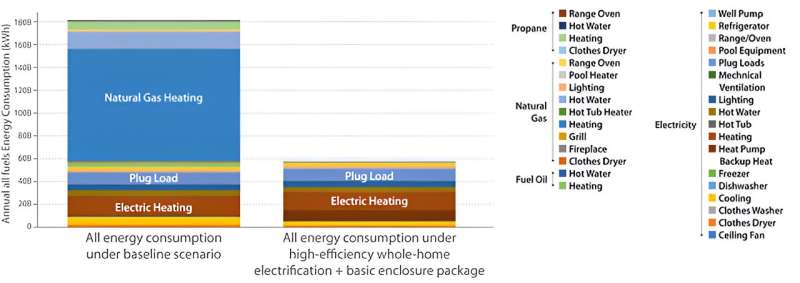This article has been reviewed according to Science X's editorial process and policies. Editors have highlighted the following attributes while ensuring the content's credibility:
fact-checked
trusted source
proofread
Researchers reveal how buildings across United States do, and could, use energy

Buildings are responsible for 40% of total energy use in the United States, including 75% of all electricity use and 35% of the nation's carbon emissions. Although today's decarbonization efforts often focus on renewable electricity or electric vehicles, decarbonizing the building stock is also essential.
To facilitate decarbonization of the U.S. building stock, researchers at the U.S. Department of Energy's National Renewable Energy Laboratory (NREL) have created a new, meticulously researched data set that details how buildings do—and could—use energy. This data set, called the End-Use Load Profiles, reveals the massive climate impacts that improvements to the U.S. building stock could have.
"Before this data set existed and was public, the options available for representing buildings' energy consumption, or their potential energy consumption, were very limited, and most of them were very expensive," said Elaina Present, a researcher in NREL's Residential Buildings Research Group and a key member of the project. "NREL's End-Use Load Profiles have completely changed that."
Jared Landsman, senior managing consultant at Energy and Environmental Economics (E3), added, "Before the [End-Use Load Profiles] data sets were released, there was limited data available to evaluate aggregate building stock loads. It was especially difficult to capture the effect of diversified loads, requiring us to do significant simplification in our analysis. The release has really changed the game in providing reliable diversified building end-use loads for our building decarbonization studies."
Crucially, the data set provides credible answers to some of the questions and unknowns surrounding building decarbonization. Although awareness of the importance of buildings in decarbonization is growing, entities involved in updating existing buildings often do not have the information they need to make informed decisions. And if stakeholders cannot find credible answers to their questions, they often conclude that the only safe option is to do nothing.
"Any household or community interested in electrification is faced with a series of unknowns: How much will it save on energy bills? Is the emissions benefit worth the upfront cost? To what extent will electrical panels or the grid need to be upgraded?" said Cora Wyent, the director of research for Rewiring America. "NREL's data sets are specifically tailored to provide answers to all of these questions, in turn facilitating building decarbonization and all of the cost savings and emissions, workforce, and health co-benefits it brings."
Creating the data set
Creating a data set that provides accessible answers to the unknowns surrounding building decarbonization was no easy task.
To create the End-Use Load Profiles, NREL staff, led by Eric Wilson, Andrew Parker, Kim Trenbath, Anthony Fontanini, Janet Reyna, Matthew Dahlhausen, Christopher CaraDonna, and Elaina Present, along with co-Principal Investigator Natalie Mims Frick from Lawrence Berkeley National Laboratory, started with two major building energy modeling workflows developed at NREL.
The first is ResStock, which models the U.S. residential building stock, and the second is ComStock, which models the U.S. commercial building stock. (Both of these models rely on OpenStudio and EnergyPlus, tools developed by the U.S. Department of Energy and NREL.) Using ResStock and ComStock, the NREL team simulated the U.S. building stock's baseline energy usage, including energy consumption for heating, cooling, ventilation, lighting, appliances, and plug and process loads.
NREL staff spent many hours improving these baseline load profiles, comparing them to electric load data from 11 utilities and 2.3 million power meters as well as state-by-state natural gas consumption and additional data sets from the U.S. Energy Information Administration.
"On the commercial side, we had to go through a painstaking process of trying to map the meter data to buildings, and there were many technical steps involved in that," said Andrew Parker, a researcher in NREL's Commercial Buildings Research Group and a key member of the project.
After improving the baseline load profiles, NREL staff, led by Elaina Present, Christopher CaraDonna, and Lauren Klun, modeled how energy use might change under various "what-if" efficiency and electrification upgrade scenarios.
The resulting data set includes multiple sets of hundreds of thousands of modeled building energy-use profiles that reflect both the energy consumption of the building stock today and how that energy use might change under these various "what-if" efficiency and electrification upgrade scenarios—which represent a key resource for decision makers. New data are released about every six months.
"This was a significant undertaking over the course of about four years by around 40 people," Present said. "And it was hard. But as a national lab, with the expertise we had, we were able to do it."
Parker added, "It was a huge team effort. No single person was responsible for all the pieces, and we needed everybody's help to do the work."
NREL partnered with 42 organizations to gain access to building and energy usage data for specific building types, like schools. This allowed the team to further refine building characteristics and load profiles.
By comparing ResStock and ComStock's modeled load profiles to these data, the team was able to identify discrepancies. They then made focused improvements to their building stock characterizations and re-ran their models to ensure discrepancies were reduced. The research team specifically avoided automating this process to minimize error, manually improving the two models over a three-year calibration and validation effort.
-

Residential Building Data Sources. Credit: National Renewable Energy Laboratory -

Commercial Building Data Sources. Credit: National Renewable Energy Laboratory
In their final form, the End-Use Load Profiles quantitatively describe how 900,000 representative residential and commercial building models—550,000 residential and 350,000 commercial building models—currently use energy. For residential buildings, that is one building modeled for every 240 buildings that exist in the United States.
For commercial buildings, the models represent approximately 65% of commercial floor space in the United States. The 900,000 modeled buildings were simulated using NREL's high-performance computing system. The profiles are provided in 15-minute time steps for a full year for geographies throughout the country.
"This modeled data set estimates the energy consumption for the whole U.S. building stock, residential and commercial, at a high geographic resolution," Parker explained. "This new foundational data can be used by decision makers to answer the question: "How do buildings in my area use energy?'"
The end result is a comprehensive, exhaustively researched and refined data set that provides credible answers to questions around building decarbonization.
"Previously, the entities that could benefit from this data had to use simplified approaches, or data that was old, limited, or from another location," Present said. "Our data may not be perfect, but it is useful—it is so much better than what most people had available."
Catalyzing the low-carbon building transition
Ultimately, the NREL research team behind the End-Use Load Profiles hopes that the data sets will illustrate how different building decarbonization paths will affect our nation's electric grid, its energy needs, and its buildings and the people that inhabit them—helping stakeholders make informed decisions. The End-Use Load Profiles are designed to enable, prioritize, and accelerate a range of decarbonization efforts, including electrification planning, emissions analysis, utility resource planning and load forecasting, and policy and rate design.
As an example of the data set's capabilities, the NREL team used these "what-if" profiles to show that the residential housing stock of Ohio could reduce its total energy use by 68% by implementing basic insulation and air sealing improvements and switching to high-efficiency electric appliances and heat pumps. By contrast, the team found that Texas—a state with a very different climate and housing stock—would reduce energy consumption by 45% with these efficiency improvements and electrification strategies.
In this way, the profiles can be used to tease apart which energy efficiency measures will be most effective in different regions—enabling better, more informed decision-making. And because efficiency and electrification retrofits represent a major opportunity to reduce U.S. energy consumption and carbon emissions, even small improvements in decision-making can have a significant impact.
Anthony Fryer, director of energy conservation and optimization for the Minnesota Department of Commerce, said, "These data have the potential to enable Minnesota utilities to target electrification initiatives to the end uses most likely to benefit from these services. They also enable Minnesota to better estimate projected savings and benefits of such measures, which will enhance future programs."
The NREL team is working to include more options for energy efficiency upgrades, building electrification, and other electric load growth (like electric vehicle charging) into upcoming releases of the load profiles. Additionally, the team uses the data to develop novel analysis frameworks for utilities, states, and cities. As new technology deployment outpaces traditional multiyear field demonstrations, ResStock and ComStock data sets can be used to fill data gaps and reduce risk.
NREL hopes that other groups will build on the load profiles work, too.
"We want consultants and utilities and other decision makers to use the data as a starting point for their own work so that they don't have to start from scratch," Parker said. "Our goal is to be a force multiplier."
Present added, "It's really cool seeing what different people are doing with the data set. Hearing about what people are doing will help us make the tool even better in the future."
A long-awaited resource
NREL's efforts resulted in a highly impactful—and long-awaited—resource for governments, utilities, and building operators.
This is not the first time that energy load profiles have been published, but because they require significant labor and cost to develop, previous options have been limited to specific cities or regions—making them of limited use.

"If you're a city or a utility and you're making decisions, you don't care about the national energy consumption—you only care about the part of the country that you're in, or have jurisdiction over," Parker said. "And as renewables and other time-varying resources come on to the grid more and more, when you use energy also matters."
NREL's End-Use Load Profiles provide a reliable nationwide option, and as a result, they have already been widely adopted in the energy and decarbonization industries. To date, there have been more than 12 million downloads of individual data files and nearly 3,000 unique users of the online data viewer. The California Public Utilities Commission is using the load profiles to simulate the bill impacts of a rate designed to promote electrification. WattCarbon and other startups are using the load profiles to help owners of large commercial buildings implement carbon reduction plans. And the New York Independent System Operator is incorporating the load profiles into their long-term load forecasts for millions of people.
In addition, users have already turned to the load profiles to understand and respond to the Inflation Reduction Act's $369 billion funding for clean energy and weatherization subsidies and investments. For example, Rewiring America is using the load profiles to create state-by-state deployment prioritizations for the act's efficiency rebates.
"Without this type of data provided by NREL, we would be forced to use data that are either less relevant (in terms of geography or specificity) or else rely on data that are decades old," said Mike Hamilton, data scientist for Seattle City Light.
NREL's position as a trusted, independent national laboratory played a critical role in the lab's ability to produce a data set with such broad impact. The End-Use Load Profiles are informed by access to data sets (including some under nondisclosure agreements) that most other organizations cannot collect.
"We were able to access millions of meters of advanced metering infrastructure (AMI) data using the trust and the data security that we have as a national laboratory," Present said. "Then, we used that data to inform improvements to our models. We were able to run our models on our supercomputer, which is a national-lab-level resource, and this requires the right expertise. We have the people who can understand the building science, but we also have the people who can do the software engineering, who can do the high-performance computing work, who can do the data science—and we have all these people basically on one team."
Accessibility is key
The intent of the End-Use Load Profiles is to make building stock energy-use data easily accessible and understandable to many audiences. To do this, the End-Use Load Profiles offer free, public access and present results in a range of formats that allow users to select the level of detail and geographic focus that meets their needs.
The easiest way for users to browse the data sets is through the web data viewers available at comstock.nrel.gov and resstock.nrel.gov. These viewers also allow users to filter by any characteristic (e.g., location, vintage, wall type) and then download the data behind that view.
Pre-aggregated load profiles, annual data files, and a full data set of individual building load profiles—the most complex output—are also available via the Open Energy Data Initiative webpage.
"This is a public, government-funded data set," Present said, "and there really aren't limits to what you can do with it."















